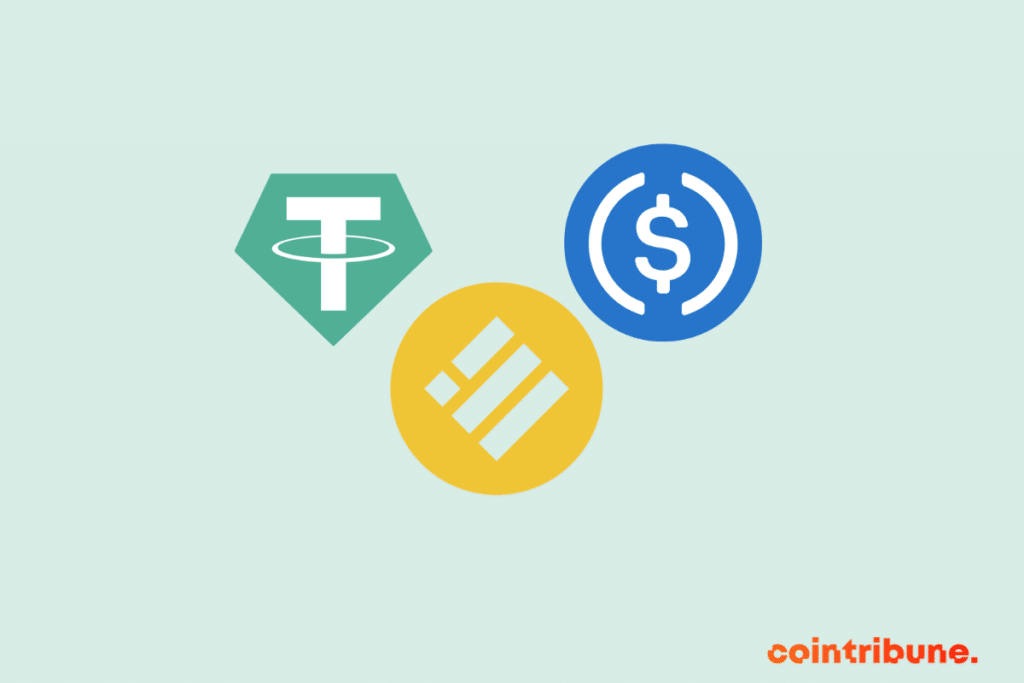💳 𝐏𝐚𝐲𝐦𝐞𝐧𝐭 𝐆𝐢𝐚𝐧𝐭𝐬 𝐄𝐦𝐛𝐫𝐚𝐜𝐞 𝐒𝐭𝐚𝐛𝐥𝐞𝐜𝐨𝐢𝐧𝐬: PayPal, Visa, Mastercard, and Stripe venture into the #stablecoin domain, signaling broader acceptance in traditional finance.
— 21e6 Capital AG (@21e6_Digital) August 16, 2023
A
A
Crypto: Stablecoins make Visa, PayPal and Mastercard quiver
Mon 04 Sep 2023 ▪
4
min read ▪ by
▪
Stablecoin
Several reports on the performance of dollar-backed digital currencies suggest that crypto wallets containing stablecoins will eventually replace credit cards. The appetite for dollar-backed stablecoins in payments is increasingly surprising, and could even pose a threat to the business model of traditional payment companies such as Visa, PayPal and MasterCard. What do traditional payment companies have to say about this silent competitor?

Over $11,000 billion in transactions thanks to stablecoins
Considering the relative security they offer in a world flagellated by uncontrollable inflation, stablecoins have rapidly become an alternative way of protecting the value of digital assets and privileged gateways into the world of digital currencies.
Today, dollar-backed stablecoins have won the hearts of users, garnering ever-increasing volumes of transactions. A report published by the press this August 23 reveals that stablecoins were used to process over $11 trillion in 2022 via the blockchain.
This figure far exceeds the volume of transactions processed by PayPal, on the one hand, and is on a par with the $11.6 trillion worth of transactions processed by Visa, on the other. It’s easy to see why MasterCard is keen to stay at the forefront of stablecoin-related issues.
What’s more, over 25 million wallets on the blockchain contain more than $1 worth of stablecoins, while more than 80% of these wallets contain around $100 worth of stablecoins. If blockchain were a bank with 25 million accounts, it would be the 5th largest bank in the USA. Go figure why the US has suddenly decided to recognize stablecoins as a form of currency!
Stablecoins: the ideal alternative for cross-border transactions?
The volume of transactions settled with stablecoins in 2022 suggests that blockchain technology holds the key to revolutionizing financial services on a global scale. Dollar-backed digital currencies offer an alternative platform improving access to financial services for underbanked populations, and faster, cheaper transactions.
As a reminder, global payments giant PayPal had launched its own stablecoin, PYUSD, at the dawn of this month in collaboration with blockchain company Paxos. Unfortunately, the PYUSD share price has seen an 18% decline since then. Some analysts claim that stablecoins have a general tendency to be more popular outside the US than inside.
In any case, the future of stablecoins will depend above all on the implementation of clear regulations on digital assets. This will prevent stablecoins from seeing their value simply crushed, as was the case with Binance’s BUSD, which has lost almost 80% of its value since the SEC affair, leaving Tether USD, USD Coin and DAI to dominate, with market shares of 67%, 21% and just over 3% respectively.
Maximize your Cointribune experience with our "Read to Earn" program! For every article you read, earn points and access exclusive rewards. Sign up now and start earning benefits.
A
A
Diplômé de Sciences Po Toulouse et titulaire d'une certification consultant blockchain délivrée par Alyra, j'ai rejoint l'aventure Cointribune en 2019. Convaincu du potentiel de la blockchain pour transformer de nombreux secteurs de l'économie, j'ai pris l'engagement de sensibiliser et d'informer le grand public sur cet écosystème en constante évolution. Mon objectif est de permettre à chacun de mieux comprendre la blockchain et de saisir les opportunités qu'elle offre. Je m'efforce chaque jour de fournir une analyse objective de l'actualité, de décrypter les tendances du marché, de relayer les dernières innovations technologiques et de mettre en perspective les enjeux économiques et sociétaux de cette révolution en marche.
DISCLAIMER
The views, thoughts, and opinions expressed in this article belong solely to the author, and should not be taken as investment advice. Do your own research before taking any investment decisions.